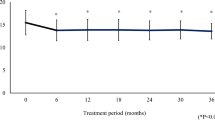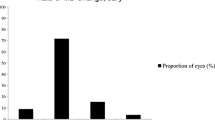Abstract
Purpose
To compare the effects of topical nipradilol and timolol on the visual field in Japanese normaltension glaucoma (NTG) patients.
Methods
We enrolled 146 NTG patients. At baseline, age, intraocular pressure (IOP), and mean deviation (MD) by the Humphrey field analyzer were 47.6 (SD 8.5), 14.2 (1.7) mmHg, and −4.5 (3.0) dB. Seventy-two patients were randomly assigned to the 0.25% nipradilol group and 74 patients to the 0.5% timolol ophthalmic solution group twice daily for the 3-year study period. The Humphrey full-threshold 30-2 visual field test was performed every 6 months. The primary end point was the nonparametric O’Brien summary score (sum of the ranks of six slopes calculated from the average of the total deviation in each cluster) in each patient. The secondary analyses were differences in the MD slope, average of the total deviation in each cluster, the corrected pattern standard deviation (CPSD), and the time course of IOP.
Results
No significant intergroup differences were found in baseline characteristics, or in the parameters of the primary and secondary analyses. In both groups, central superior clusters showed negative slopes and IOP decreased by about 1 mmHg from baseline.
Conclusion
No significant difference in visual field performance or IOP reduction was seen between the nipradilol and timolol groups.
Similar content being viewed by others
References
Collaborative Normal-Tension Glaucoma Study Group. Comparison of glaucomatous progression between untreated patients with normal-tension glaucoma and patients with therapeutically reduced intraocular pressure. Am J Ophthalmol 1998;126:487–497.
Collaborative Normal-Tension Glaucoma Study Group. The effectiveness of intraocular pressure reduction in the treatment of normal-tension glaucoma. Am J Ophthalmol 1998;126:498–505.
The AGIS Investigators. The Advanced Glaucoma Intervention Study (AGIS): 7. The relationship between control of intraocular pressure and visual field deterioration. Am J Ophthalmol 2000;130:429–440.
Lichter PR, Musch DC, Gillespie BW, et al. CIGTS Study Group. Interim clinical outcomes in the Collaborative Initial Glaucoma Treatment Study comparing initial treatment randomized to medications or surgery. Ophthalmology 2001;108:1943–1953.
Heijl A, Leske MC, Bengtsson B, et al. The Early Manifest Glaucoma Trial Group. Reduction of intraocular pressure and glaucoma progression. Results from the Early Manifest Glaucoma Trial. Arch Ophthalmol 2002;120:1268–1279.
Anderson DR. The damage caused by pressure. XLVI Edward Jackson Memorial Lecture. Am J Ophthalmol 1989;108:485–495.
Fechtner RD, Weinreb RN. Mechanisms of optic nerve damage in primary open-angle glaucoma. Surv Ophthalmol 1994;39:23–42.
Araie M, Azuma I, Kitazawa Y. Influence of topical betaxolol and timolol on visual field in Japanese open-angle glaucoma patients. Jpn J Ophthalmol 2003;47:199–207.
Kitazawa Y, Shirai H, Go FJ. The effect of Ca2+-antagonist on visual field in low-tension glaucoma. Graefes Arch Clin Exp Ophthalmol 1989;227:408–412.
Sawada A, Kitazawa Y, Yamamoto T, Okabe I, Ichien K. Prevention of visual field defect progression with brovincamine in eyes with normal-tension glaucoma. Ophthalmology 1996;103:283–288.
Koseki N, Araie M, Yamagami J, Shirato S, Yamamoto S. Effects of oral brovincamine on visual field damage in patients with normal-tension glaucoma with low-normal intraocular pressure. J Glaucoma 1999;8:117–123.
Uchida Y, Nakamura M, Shimizu S, Fujii M. Vasoactive and β-adrenoceptor blocking properties of 3,4-dihydro-8-(2-hydroxy-3-isopropylamino) propoxy-3-nitroxy-2H-1-benzopyran (K-351), a new antihypertensive agent. Arch Int Pharmacodyn 1983;262:132–149.
Ohira A, Wada Y, Fujii M, et al. Effects of nipradilol (K-351) on alpha-adrenoceptor mediated responses in various isolated tissues. Arch Int Pharmacodyn 1985;278:61–71.
Kanno M, Araie M, Tomita K, Sawanobori K. Effects of topical nipradilol, a β-blocking agent with α-blocking and nitroglycerinlike activities, on aqueous humor dynamics and fundus circulation. Invest Ophthalmol Vis Sci 1998;39:736–743.
Kanno M, Araie M, Koibuchi H, Masuda K. Effects of topical nipradilol, a β blocking agent with α blocking and nitroglycerin-like activities, on intraocular pressure and aqueous dynamics in humans. Br J Ophthalmol 2000;84:293–299.
Kanno M, Araie M, Masuda K, et al. Phase III long-term study and comparative clinical study of nipradilol ophthalmic solution in patients with primary open-angle glaucoma and ocular hypertension. Arzneimittelforschung 2006;56:729–734.
Kanno M, Araie M, Masuda K, et al. Phase III long-term study and comparative clinical study of nipradilol ophthalmic solution in patients with primary open-angle glaucoma and ocular hypertension. Arzneimittelforschung 2006;56:820–825.
Mizuno K, Koide T, Yoshimura M, Araie M. Neuroprotective effect and intraocular penetration of nipradilol, a β-blocker with nitric oxide donative action. Invest Ophthalmol Vis Sci 2001;42:688–694.
Kashiwagi K, Iizuka Y, Tsukahara S. Neuroprotective effects of nipradilol on purified cultured retinal ganglion cells. J Glaucoma 2002;11:231–238.
Mizuno K, Koide T, Saito N, et al. Topical nipradilol: effects on optic nerve head circulation in humans and periocular distribution in monkeys. Invest Ophthalmol Vis Sci 2002;43:3243–3250.
Matts JP, Lachin JM. Properties of permuted-block randomization in clinical trials. Control Clin Trials 1988;9:327–344.
Gordon MO, Beiser JA, Brandt JD, et al. The Ocular Hypertension Treatment Study: baseline factors that predict the onset of primary open-angle glaucoma. Arch Ophthalmol 2002;120:714–720.
O’Brien PC. Procedures for comparing samples with multiple endpoints. Biometrics 1984;40:1079–1087.
Suzuki Y, Kitazawa Y, Araie M, et al. Mathematical and optimal clustering of test points of the central 30-degree visual field of glaucoma. J Glaucoma 2001;10:121–128.
Mayama C, Araie M, Suzuki Y, et al. Statistical evaluation of the diagnostic accuracy of methods used to determine the progression of visual field defects in glaucoma. Ophthalmology 2004;111:2117–2125.
Shigeeda T, Tomidokoro A, Araie M, Koseki N, Yamamoto S. Long-term follow-up of visual field progression after trabeculectomy in progressive normal-tension glaucoma. Ophthalmology 2002;109:766–770.
Nakazawa T, Tomita H, Yamaguchi K, et al. Neuroprotective effect of nipradilol on axotomized rat retinal ganglion cells. Curr Eye Res 2002;24:114–122.
Taniai M, Sato E, Mizota A, Adachi-Usami E. Protective action of nipradilol against ischemia-induced retinal damage in rats. Ophthalmic Res 2002;34:331–337.
Tomita H, Nakazawa T, Sugano E, Abe T, Tamai M. Nipradilol inhibits apoptosis by preventing the activation of caspase-3 via S-nitrosylation and the cGMP-dependent pathway. Eur J Pharmacol 2002:452:263–268.
Ando A, Yamazaki Y, Kaneko S, et al. Cytoprotection by nipradilol, an anti-glaucomatous agent, via down-regulation of apoptosis related gene expression and activation of NF-κB. Exp Eye Res 2005;80:501–507.
Osborne NN, Cazevieille C, Carvalho AL, Larsen AK, DeSantis L. In vivo and in vitro experiments show that betaxolol is a retinal neuroprotective agent. Brain Res 1997;751:113–123.
Gross RL, Hensley SH, Gao F, Wu SM. Retinal ganglion cell dysfunction induced by hypoxia and glutamate: potential neuroprotective effects of β-blockers. Surv Ophthalmol 1999;43Suppl 1:S162–170.
Acheampong AA, Shackleton M, John B, Burke J, Wheeler L, Tang-Liu D. Distribution of brimonidine into anterior and posterior tissues of monkey, rabbit, and rat eyes. Drug Metab Dispos 2002;30:421–429.
Ichikawa M, Okada Y, Asai Y, Hara H, Ishii K, Araie M. Effects of topically instilled bunazosin, an α1-adrenoceptor antagonist, on constrictions induced by phenylephrine and ET-1 in rabbit retinal arteries. Invest Ophthalmol Vis Sci 2004;45:4041–4048.
Anderson DR, Drance SM, Schulzer M; Collaborative Normal-Tension Glaucoma Study Group. Natural history of normal-tension glaucoma. Ophthalmology 2001;108:247–253.
Tomita G, Araie M, Kitazawa Y, Tsukahara S. A three-year prospective, randomized and open comparison between latanoprost and timolol in Japanese normal-tension glaucoma patients. Eye 2004;18:984–989.
Goto W, Ota T, Morikawa N, et al. Protective effects of timolol against the neuronal damage induced by glutamate and ischemia in the rat retina. Brain Res 2002;958:10–19.
Chen YN, Yamada H, Mao W, Matsuyama S, Aihara M, Araie M. Hypoxia-induced retinal ganglion cell death and the neuroprotective effects of β-adrenergic antagonists. Brain Res 2007;1148:28–37.
Werner EB, Drance SM. Early visual field disturbances in glaucoma. Arch Ophthalmol 1977;95:1173–1175.
Hart WM Jr, Becker B. The onset and evolution of glaucomatous visual field defects. Ophthalmology 1982;89:268–279.
Yamada Y, Takayanagi R, Tsuchiya K, et al. Assessment of systemic adverse reactions induced by ophthalmic β-adrenergic receptor antagonists. J Ocul Pharmacol Ther 2001;17:235–248.
Yamada Y, Takayanagi R, Ozeki T, Yokoyama H, Iga T, Araie M. Predicting systemic adverse effects associated with nipradilol ophthalmic solution based on β-receptor occupancy. Atarashii Ganka (J Eye) 2006;23:87–94.
Author information
Authors and Affiliations
Consortia
Corresponding author
About this article
Cite this article
Araie, M., Shirato, S., Yamazaki, Y. et al. Clinical efficacy of topical nipradilol and timolol on visual field performance in normal-tension glaucoma: a multicenter, randomized, double-masked comparative study. Jpn J Ophthalmol 52, 255–264 (2008). https://doi.org/10.1007/s10384-008-0540-z
Received:
Accepted:
Published:
Issue Date:
DOI: https://doi.org/10.1007/s10384-008-0540-z




